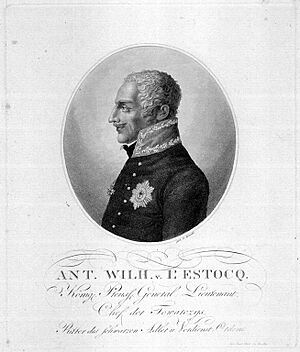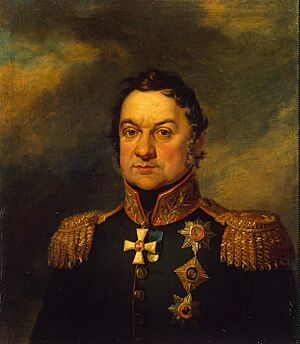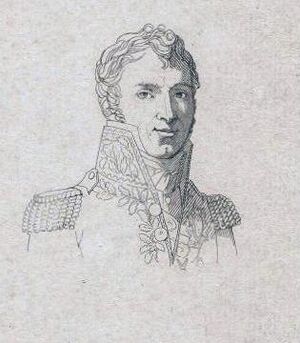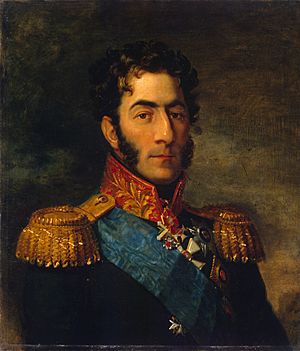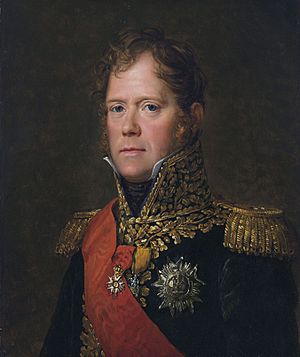Battle of Guttstadt-Deppen facts for kids
Quick facts for kids Battle of Guttstadt-Deppen |
|||||||
|---|---|---|---|---|---|---|---|
| Part of the War of the Fourth Coalition | |||||||
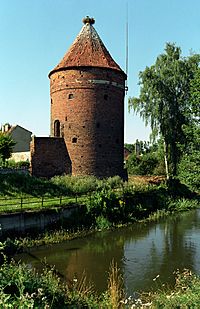 The Stork Tower (Baszta Bociania) in Dobre Miasto |
|||||||
|
|||||||
| Belligerents | |||||||
| Commanders and leaders | |||||||
| Strength | |||||||
| Guttstadt: 17,000 Lomitten: 6,000, 16 guns Spanden: unknown |
Guttstadt: 63,000 Lomitten: 12,000, 76 guns Spanden: 6,000 |
||||||
| Casualties and losses | |||||||
| Guttstadt: 2,042 Lomitten: 1,185 Spanden: unknown |
Guttstadt: 2,000–2,500 Lomitten: 2,800 Spanden: 500–800 |
||||||
The Battle of Guttstadt-Deppen was a fight between the Russian Empire and Prussia against the First French Empire on June 5 and 6, 1807. It was part of the War of the Fourth Coalition, which was a bigger conflict within the Napoleonic Wars. The battle took place near Guttstadt in what is now Poland.
During this battle, Russian General Levin August, Count von Bennigsen attacked the French forces led by Marshal Michel Ney. Even though Ney's troops were greatly outnumbered, he managed a clever fighting retreat, also known as a "rearguard action." This means his soldiers fought bravely while slowly moving back to protect the main army. By June 6, Ney successfully pulled his troops back across the Pasłęka River.
Contents
Background: What Led to the Battle?
After a very bloody battle called Battle of Eylau in February 1807, both the French and Russian armies were tired. Emperor Napoleon I's soldiers wanted peace. The French army then moved into winter camps. Marshal Ney's troops were in an advanced position at Guttstadt, while other French forces were spread out.
Before the Battle of Guttstadt-Deppen, an important event happened: the Siege of Danzig. French Marshal François Joseph Lefebvre had been trying to capture the city of Gdańsk (Danzig) since March 1807. The city finally surrendered on May 24. This victory was important for Napoleon because it secured his army's rear (the area behind them) and freed up many French soldiers for other battles.
The Battle Begins
With Danzig now under French control, Napoleon planned to start a major attack around June 10. However, the Russian commander, General Bennigsen, decided to attack first. Bennigsen gathered his army and moved towards Napoleon's lines on June 2.
Bennigsen's Plan to Trap Ney
General Bennigsen wanted to destroy Marshal Ney's army corps because it was in an exposed position. He planned a complex attack using six different groups of soldiers, called columns, to surround Ney.
- One column, led by Lieutenant General Dmitry Dokhturov, was to attack French troops near the Pasłęka River.
- Another column, led by Lieutenant General Fabian Gottlieb von Osten-Sacken, would hit Ney's left side.
- Lieutenant General Pyotr Bagration led a third column to attack north of Guttstadt, hoping to cut off some of Ney's soldiers.
- Other columns, led by Lieutenant General Aleksey Gorchakov and Major General Matvei Platov, were ordered to cross the Łyna River and attack Ney's right side.
- The Russian Imperial Guard, led by Grand Duke Constantine Pavlovich of Russia, was kept as a reserve force.
Bennigsen also ordered the Prussian general Anton Wilhelm von L'Estocq to attack Marshal Jean-Baptiste Bernadotte's French troops further north, to keep them busy and prevent them from helping Ney.
The Russian plan relied on surprising the French. However, French scouts found out about the Russian movements, which gave Marshal Ney time to prepare his troops. He ordered his forces to gather between Guttstadt and Deppen and asked for help from nearby French marshals.
Fighting at Spanden
On June 4, Prussian General L'Estocq's troops attacked a French position at Spanden. This was a day earlier than Bennigsen's main attack plan, due to a mix-up in orders. The French, led by General of Division Eugene-Casimir Villatte, had built strong defenses at a bridgehead (a protected area on the enemy's side of a river).
On June 5, the Prussians attacked again. After two hours of artillery fire, Russian infantry charged the French defenses. However, the French soldiers waited until the Russians were very close before firing, causing heavy losses. The Russians were forced to retreat. The French lost few soldiers, but Marshal Bernadotte was wounded in the head and had to give up command of his corps.
Fighting at Lomitten
Also on June 5, Russian General Dokhturov attacked Marshal Nicolas Soult's French troops at Stolno (Warmian-Masurian Voivodeship). The French, led by General of Division Claude Carra Saint-Cyr, defended a bridgehead on the east bank of the Pasłęka River. They had built two small forts and earthworks.
Dokhturov's troops attacked the French defenses multiple times. The fighting lasted for eight hours. The French fought bravely, holding their ground even when the Russians tried to storm their positions. Eventually, the French commander was allowed to pull his troops back because the Russian artillery had badly damaged their defenses. The French still managed to block the bridge, and the Russians retreated by evening. The French reported about 1,185 casualties, while the Russians had about 2,800.
The Main Battle at Guttstadt-Deppen
Marshal Ney had about 17,000 soldiers, while Bennigsen's Russian and Prussian army had around 63,000 troops. Ney's forces were spread out in villages like Guttstadt and Deppen.
On the morning of June 5, Russian General Bagration attacked and quickly captured Altkirch. Ney used this moment to pull back some of his troops and then launched a strong counterattack, causing the Russians to lose 500 soldiers. As more Russian columns attacked Ney's left side, he began a fighting retreat, using small groups of soldiers called skirmishers to slow down the enemy.
Gorchakov's troops took Guttstadt after the French left it. By 3:00 PM, Ney had taken up a new defensive position. The fighting ended for the day along this line.
On the morning of June 6, Ney was still holding his position. The Russian attacks started again at 5:00 AM, with different columns trying to break through Ney's lines and capture the bridge at Deppen to cut off his escape. Ney's defense was very strong, especially against Gorchakov's attack. At one point, Gorchakov made a mistake by moving his soldiers away from the battle for a few hours, trying to get around Ney's flank. This gave Ney a chance to move his troops around and strengthen his weaker areas. Ney then skillfully pulled his entire corps back across the bridge at Deppen, escaping with very few additional losses.
Aftermath
The Battle of Guttstadt-Deppen was a tactical victory for the Russians and Prussians because they pushed the French back. However, it was a strategic victory for the French because Marshal Ney managed to escape with most of his army, despite being greatly outnumbered. General Bennigsen was very angry that he failed to destroy Ney's corps.
The French lost about 2,042 soldiers (killed, wounded, or captured), along with some cannons and supplies. The Russians lost around 2,000 to 2,500 soldiers.
After the battle, Bennigsen ordered his army to retreat on the evening of June 7. Napoleon immediately began preparing his own counterattack. A few days later, on June 10, Bennigsen's army fought Napoleon at the Battle of Heilsberg, where the Russians managed to hold their ground. However, the truly decisive battle of the war happened on June 14, 1807, at Friedland, where Napoleon won a major victory. This led to the Peace of Tilsit, which ended the War of the Fourth Coalition.
Images for kids



